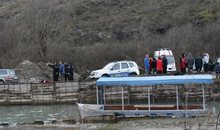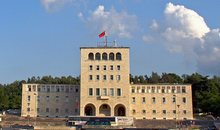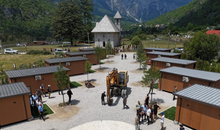
 Flash News
Flash News
With the eagle symbol, Torino presents the purchase of the Albanian national team defender
Eraldo Muçi's disappearance, his mother's testimony comes to light: My son was friends with Sanço
28 arrested in Italy and Spain for drug trafficking, including an Albanian
Residents clash with police in Theth: We are on our land
The case of the murder of the Italian teacher is reopened, a 47-year-old Albanian suspect is suspected
Albania is losing young people: Emigration is emptying the labor market, by 2050 the labor force will fall by 20–25%

Just a day ago, an expert from the Vienna Institute for International Economic Studies (wiiw ) warned in an interview with Politiko.al that "brain drain is weakening the Albanian economy."
But what is happening in Albania is no longer simply a "brain drain," but a silent and ongoing emptying of the younger generation, which is leaving behind a country with a fragile economy and a labor market in crisis.
This is because in the last decade, Albania has faced a continuous wave of emigration, where at the center of this phenomenon are mainly young people aged 18–35. For more detailed information after this alarm, Politiko.al asked INSTAT, while the latter responded that " the movements of people entering and leaving the country (international migration) is the most difficult component to measure, given that Albania does not yet have a population register for statistical purposes.
In this way, INSTAT uses the best 'proxy' data for the assessment of migration, based mainly on data collected by the migration module through the labor force survey combined with the coefficients of the 2011-2031 population projections.
In the following, INSTAT refers to its study and the International Organization for Migration (IOM) entitled "Foresight Modeling: The Impact of Migration on the Albanian Labor Force and Skills Development Needs from a Gender Perspective" , which is leaving profound consequences on the country's economy.
According to this report, young Albanians are leaving en masse, leaving behind an empty job market with a fragile economy.
Who is leaving?
According to the report, the 18–35 age group makes up the majority of Albanian emigrants, with the majority being men, but with a significant increase in the participation of women in labor migration.
"Young people constitute a significant portion of the population leaving Albania, directly impacting the structure of the labor force and the country's development potential," the report states.
The main motivation for emigration remains economic, followed by the desire for education and family reunification, while the most preferred countries are Germany, Italy and the United Kingdom.
Sectors most affected?
The report highlights that youth emigration has created large gaps in several key sectors of the economy.
Sectors such as construction, tourism, and healthcare are most exposed to labor shortages due to youth emigration.
Specifically, construction will face a shortage of qualified labor
, tourism will face difficulties in finding seasonal and trained staff
, healthcare will face the emigration of young doctors and nurses,
and technology will face a shortage of IT and innovation professionals.
The graphs in the report (page 24) clearly show the decline in labor market participation in these sectors, especially in rural and peripheral areas.
What awaits us if we don't change strategy?
According to the report, the working-age population is expected to fall♪7 by 20–25% by 2050, the demographic dependency ratio will increase: more elderly people for every employed person, the social security system will face great pressure due to the lack of new contributors.
“If the current migration trend continues, Albania will face a steady contraction of the active population and serious challenges to the sustainability of the social security system,” the report says.
Thus, youth immigration is no longer a statistic, but an alarm bell that requires immediate action because if we do not take concrete steps, Albania risks remaining a country without a future.
Latest news


Tabaku: Salianji bore a political cost that no one in Albania has borne
2025-07-08 22:36:15


Sekretet për të shijuar verën si një ‘profesionist’
2025-07-08 21:45:06


Albania's Waste Crisis: Toxic Smoke and Deep Governance Problems
2025-07-08 21:13:07
Alarming pollution in Fushë-Arrëz, copper factory waste turns the Fan River red
2025-07-08 21:07:14

Poll/ How do you assess the Prime Minister's intervention in local government?
2025-07-08 20:40:01
28 arrested in Italy and Spain for drug trafficking, including an Albanian
2025-07-08 20:24:14
Residents clash with police in Theth: We are on our land
2025-07-08 20:11:41
Death of 27-year-old in Lipjan, Osmani: To be investigated independently!
2025-07-08 20:06:52
Trump promises US will send more weapons to Ukraine
2025-07-08 19:54:25

EU targets health, education, police and cadastre as areas of corruption
2025-07-08 19:23:34




Salianji after his return: I did not oppose for functions, but for vocation
2025-07-08 18:23:15
Will he run in the 2029 elections? Here's how Salianji answers
2025-07-08 18:16:09
Boat captain drowns after diving into water to save two tourists in Shkodra
2025-07-08 18:05:12
Salianji from the DP headquarters: I brought a drug trafficker to justice
2025-07-08 18:03:26
After Fier, Rama "landes" in Durrës, dismissals expected
2025-07-08 17:53:32
Ervin Salianji arrives at the blue headquarters, welcomed by supporters
2025-07-08 17:45:12

EU approves final steps for Bulgaria's Eurozone membership
2025-07-08 17:43:06

Zhupa after Salianj's release: Inspiration for every opposition member
2025-07-08 17:19:39
Actor David Killick passes away
2025-07-08 17:09:23



Threatened with dismissals, Rama arrives at the Fier municipality
2025-07-08 16:39:19
Extreme temperatures temporarily close Acropolis in Greece
2025-07-08 16:30:34

A plot of cannabis is discovered in Mazha, Kruja
2025-07-08 16:13:48

Republika Srpska allocates additional 22 million euros for lobbying in the US
2025-07-08 15:52:04

Spices that protect you from mosquitoes!
2025-07-08 15:30:03

Accident on the Vlora-Qeparo axis, one injured
2025-07-08 15:11:52
Berat, 17 years part of UNESCO's world heritage
2025-07-08 15:03:30


Cost of living increases, inflation rises to 2.4% in June, driven by food
2025-07-08 14:29:54
VIDEO/ Restaurant roof collapses in Italy, one victim and ten injured
2025-07-08 14:18:44
Requested release from cell, Supreme Court leaves Veliaj in prison
2025-07-08 14:07:41
TikTok shutdown/ Austrian media: Rama benefited politically from the app ban
2025-07-08 13:48:25
Acropolis temporarily closed due to heat
2025-07-08 13:31:09



Salianj's release/Berisha: He was politically condemned by Rama and Xhafa!
2025-07-08 13:00:13

Knife attack on Peshkopia Boulevard
2025-07-08 12:44:10


Fier Court decides on the conditional release of Ervin Salianj
2025-07-08 12:15:23
Cost of living increases, inflation rises to 2.4% in June due to food
2025-07-08 12:00:16


Requesting conditional release, Ervin Salianji arrives at the Fier Court
2025-07-08 11:16:36
The first phase of university applications begins today
2025-07-08 11:10:52
Fire in Lura, flames endanger the National Park
2025-07-08 10:53:43
Trump warns of 35% tariffs on Serbia and 30% on Bosnia and Herzegovina
2025-07-08 10:37:32
Thethi rooster and the dung cock
2025-07-08 10:24:01

Fire in Dukat endangers Llogara National Park
2025-07-08 10:01:39
International drug search: 36-year-old arrested in Durrës (NAME)
2025-07-08 09:50:48
Thethi, tourists "criticize" modern trend
2025-07-08 09:39:54
Fire on Mount Dukat still active, Llogara National Park at risk
2025-07-08 09:28:12
Veliaj's appeal to be heard today in the High Court
2025-07-08 09:16:02
"Bad sign for democracy"/ Parliament neglects reporting by institutions
2025-07-08 09:04:56
Today's hearing at the Fier Court, Salianji requests conditional release
2025-07-08 08:56:39


Horoscope, what do the stars have in store for you today?
2025-07-08 08:16:19
Weather forecast/ How temperatures will vary throughout the day
2025-07-08 08:02:37
Morning Post/ In 2 lines: What mattered yesterday in Albania
2025-07-08 07:48:30





Marrëdhënia që s’është romancë, por s’është as thjesht kolegiale
2025-07-07 21:39:13
Citizen is asked to pay 2.5 million for a non-existent meter
2025-07-07 21:28:03




What is the ideal air conditioner temperature in summer?
2025-07-07 20:53:46
GJKKO left him in prison, Meta appeals the decision
2025-07-07 20:38:05
Where is Ronaldo after missing Diogo Jota's funeral?
2025-07-07 20:38:04

Messages from the author who killed Ilaria Sulla in Rome are revealed
2025-07-07 20:20:12
